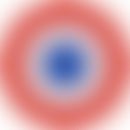Synonym(s)
DefinitionThis section has been translated automatically.
Hyaluronic acid is an important mucopolysaccharide (glycosaminoglycan) in which glucuronic acid is glycosidically linked to N-acetylglucosamine. This in turn is linked to the next glucuronic acid in the polymeric chain. A chain typically consists of 250 to 50,000 disaccharide units. Hyaluronic acid is a viscous substance with an enormous water-binding capacity. 1g hyaluronic acid can bind about 6L of water. Hyaluronic acid is a component of the extracellular matrix (ECM) of vertebrates.
Hyaluronic acid is obtained partly from animal source material (e.g. cockscomb) or biotechnologically. In the case of hyaluronic acid products obtained from cockscombs, allergic reactions can occur if there is a sensitization to bird proteins (contamination of the preparations).
Hyaluronic acid is present in many tissues, including the connective tissue of the skin as a long-chain polysaccharide and gives the tissue plastic firmness. For example, the vitreous body of the human eye consists of 98% water bound to 2% hyaluronic acid. Furthermore, hyaluronic acid is the main component of the joint synovia.
Furthermore, hyaluronic acid is involved in the formation of even larger proteoglycans (e.g. in hyaline cartilage).
The hyaluronic acid is assembled by integral membrane enzymes (hyaluronic acid synthases). Vertebrates possess 3 different HA synthases (HAS1 - HAS3). These enzymes constantly transfer new monosaccharide building blocks into the growing chain. The monosaccharide is finally removed from the cell by an ABC transporter and reaches the interstitium.
Hyaluronic acid applications are widely used in medicine.
Field of application/useThis section has been translated automatically.
Medical and cosmetic indications:
Hyaluronic acid for acute and chronic wounds:
The use of hyaluronic acid in hydrogels for wound care is being promoted. Reliable results remain to be seen.
Hyaluronic acid for dry mucous membranes
Some nasal sprays contain hyaluronic acid to counteract the drying out of the nasal mucous membranes. Hyaluronic acid can also be used in eye drops to treat sicca symptoms (dry eyes).
Intra-articular applications of hyaluronic acid for osteoarthritis
Experts are doubtful as to the actual efficacy of hyaluronic acid.
Use of hyaluronic acid as an injectable filling material in aesthetic medicine
The use of hyaluronic acid in aesthetic medicine is a long-established procedure. Hyaluronic acid preparations are by far the most commonly used materials as injectable filling materials (fillers) for wrinkle injections. Hyaluronic acid fillers are also used to model the lips (augmentation, "spraying on") or to build up facial contours. The effect of hyaluronic acid-based fillers is maintained for 6-9 months. The treatment can be repeated as often as required. Preparations based on non-animal, stabilized hyaluronic acid (NASHA) are becoming increasingly common. These preparations have been specially developed for the treatment of body deformities.
The use of hyaluronic acid in the treatment of atrophic scars (scars that have sunk below the skin level) is being promoted. It is unclear to what extent this procedure triggers collagen production and thus produces a lasting effect.
Hyaluronic acid for topical use in cosmetics
Hyaluronic acid preparations are widely used in cosmetics, including oral (!) preparations. As the hyaluronic acid molecules are not absorbed by the skin due to their size, hyaluronic acid fragments (hydrolyzed sodium hyaluronate) are used for this purpose. This "low-molecular hyaluronic acid" is assumed to penetrate the skin. Some studies with positive results are available, which require further confirmation.
Noteworthy are allergenic reactions to delayed allergic local reactions to hyaluronic filler material which have been repeatedly described in the context of mRNA COVID vaccinations (Munavalli GG et al. 2022 -S.a. Impfreaktionen kutane).
Note: Hyaluronic acid is also available mainly in tablet form as a dietary supplement.
Undesirable effectsThis section has been translated automatically.
Side effects were injection-related infections (erysipelas, abscesses) as well as late onset (after 8-10 weeks) local granulomatous reactions, which occurred in 0.5% and 4.5% of treated subjects, depending on the study. Furthermore, activation of sarcoidosis has been described. Generalized exanthema may occur after intra-articular injections of hyaluronic acid.
Very rare side effects include allergic shock, bruising of the joint, severe acute inflammatory reactions, rhinitis, joint stiffness, tenosynovitis, bursitis, fever, and muscle pain.
In rare cases, partial or complete loss of vision occurs with injections in the upper part of the face, i.e. the nose, glabella or forehead; in 98% of those affected, this was a unilateral visual impairment. The symptoms usually appear directly after the treatment: severe pain in the eye region, restriction of vision, ptosis, ophthalmoplegia, exotropia, pupillary disturbances or unspecific complaints such as headache , also nausea. Embolic occlusions of the hyaluron filler with occlusion of retinal arteries are suspected.
LiteratureThis section has been translated automatically.
- Beleznay K et al.(2015) Delayed-onset nodules secondary to a smooth cohesive 20 mg/mL hyaluronic acid filler: cause and management. Dermatol Surg 41:929-939.
- Beniamino P et al. (2016) Cross-linked hyaluronic acid in pressure ulcer prevention. J Wound Care 25:400-405.
- Bulam H et al. (205) A severe acute hypersensitivity reaction after a hyaluronic acid with lidocaine filler injection to the lip. Arch Plast Surg 42:245-247.
- Dalmedico MM et al. (2016) Hyaluronic acid covers in burn treatment: a systematic review. Rev Esc Enferm USP 50:522-528.
- França Wanick FB et al. (2016) Skin Remodeling Using Hyaluronic Acid Filler Injections in Photo-Aged Faces. Dermatol Surg 42:352-359.
- Goodman GJ (2015) An interesting reaction to a high- and low-molecular weight combination hyaluronic acid. Dermatol Surg 41 Suppl 1:S 164-166.
- König B et al. (2010) Hyaluronic acid - just a filler substance?nJ Ästhet Chir 3: 6-11
- Mermin D et al. (2016) A case of hyaluronic acid injections triggering cutaneous sarcoidosis at previously treated sites. J Eur Acad Dermatol Venereol doi: 10.1111/jdv.13719.
- Micheels P et al. (2016) Visual, Ultrasonographic, and Microscopic Study on Hyaluronic Acid-Based Gel. J Drugs Dermatol 15:1092-1098.
Munavalli GG et al. (2022) COVID-19/SARS-CoV-2 virus spike protein-related delayed inflammatory reaction to hyaluronic acid dermal fillers: a challenging clinical conundrum in diagnosis and treatment. Arch Dermatol Res 314:1-15.
- Poetschke J et al. (2016) Anti-wrinkle creams with hyaluronic acid: how effective are they?. MMW Fortschr Med 158 Suppl 4:1-6.
- Prasetyo AD et al. (2016) Hyaluronic acid fillers with cohesive polydensified matrix for soft-tissue augmentation and rejuvenation: a literature review. Clin Cosmet Investig Dermatol 9:257-280.
- Wang Y et al. (2016) Hyaluronan oligosaccharides promote diabetic wound healing by increasing angiogenesis. Pharmacol Rep 68:1126-1132.
- http://www.gd-online.de/german/veranstalt/images2012/GD_Leitlinie_Dermokosmetika_gegen_Hautalterung_1.3.2012.pdf
- Walker L et al. (2018) "This month's guideline: Visual Loss Secondary to Cosmetic Filler Injection." The Journal of clinical and aesthetic dermatology 11.5: E53-E55.




